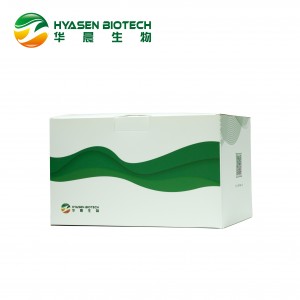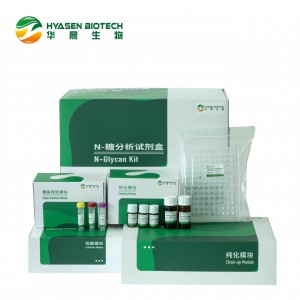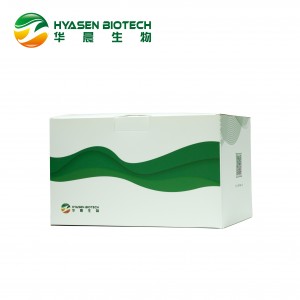
Rnase assay Kit (Fluorescence)
The RNase detection kit is based on a fluorophore-labeled RNA probe. When the sample does not contain RNase activity, the probe is stable and does not produce a fluorescent signal; when the sample contains RNase activity, the probe is degraded, resulting in a gradual enhanced fluorescence signal; the rate of increase in fluorescence signal is positively correlated with the number and activity of enzymes. Use a fluorescence microplate reader to measure at the wavelength of ex/em=535/575nm to determine whether the sample is contaminated by RNase.
Application
This kit is used to detect RNase contamination in samples.
Components
|
Name |
HCP0035A-01 (192T) |
HCP0035A-02 (48T) |
|
10×reaction solution |
2.0mL |
0.5mL |
|
RNA probe |
1tube |
1tube |
|
TE buffer |
2.0mL |
0.5mL |
|
RNase A standard (10mg/mL) |
20μL |
10μL |
|
Standard Dilution Buffer |
12mL |
6mL |
|
DNase&RNase-free water |
25mL |
25mL |
|
DNase RNase away |
50mL |
50mL |
Storage and stability
1. Transported in -25 ~ – 15 ℃;
2. The different components of the kit are stored separately according to the temperature:
|
Name |
temperature |
|
10×reaction solution |
-25 ~ – 15℃ |
|
RNA probe |
-25 ~ – 15℃ |
|
TE buffer |
-25 ~ – 15℃ |
|
RNase A standard (10mg/mL) |
-25 ~ – 15℃ |
|
Standard Dilution Buffer |
-25 ~ – 15℃ |
|
DNase&RNase-free water |
-25 ~ 30℃ |
|
DNase RNase away |
2 ~ 30℃ |
3. Store the unopened kit for 12 months.
4. Store the kit for 6 months after opening. It is recommended to aliquot the RNA probe solution according to the single use amount to avoid light and repeated freezing and thawing.
Required equipment and consumables
1. Fluorescence microplate reader (including ex/em=535/575nm wavelength)
2. DNase&RNase-free pipettes and tips
3. DNase&RNase-free EP tube
4. DNase&RNase-free black non-transparent 96-well plate
Reagent preparation
1. Take out the kit and equilibrate to room temperature (18~25℃), shake and mix the components such as 10× reaction solution, TE buffer, RNase A standard (10mg/mL), Standard Dilution Buffer, and then centrifuge immediately. (Centrifuge at 4000~7000rpm for 10 seconds).
2. Centrifuge the RNA probe at 4000~7000rpm for 60 seconds to gather it to the bottom of the tube, carefully open the tube cap, and add 40μL TE buffer to dissolve as the RNA probe storage solution, aliquot the RNA probe storage solution according to the single use amount and store them at -25 ~ -15 °C to avoid repeated freezing and thawing. Take out the probe storage solution at each time you test, dilute it 50 times with TE buffer (for example, add 490μL TE buffer into 12μL RNA probe) as the RNA probe working Solution. Store the rest of RNA probe working Solution at-25 ~ -15 °C to avoid light and repeated freezing and thawing.
Detection steps
1. Step to set appropriate gain before the first test, to avoid the risk of sensitivity loss or signal oversaturation.
1) instrument parameters:
Shaking plate 10~ 15s before detecting;
Excitation wavelength λEx=535nm;
Emission wavelength λEm=575nm;
Use the automatic gain function;
Temperature 37℃;
Endpoint mode.
Set the gain to auto-scale if possible, alternatively use a medium gain setting initially.
Note: the setting method of different instruments is not consistent, please consult the instrument supplier for details.
2) Select 2 wells on a 96-well plate, add 10μL RNA probe working solution and 10μL 10×reaction solution to each well;
3) Add 80μL of DNase&RNase-free water to one well, and add 79μL of DNase&RNase-free water and 1μL RNase A standard (100mg/mL) to the other well.
4) Place the plate in a dark place at 37°C and test it after 30 minutes.
5) If set the gain to autoscale, Gain value will be displayed in the instrument parameter bar of the data file, denoted as G1.
6) When using a medium gain setting initially, it should be noted that: if the high fluorescence value exceeds the upper limit of the instrument, the gain value should be appropriately reduced; if the high fluorescence value is far below the upper limit of the instrument, the gain value should be appropriately increased; Finally, the appropriate gain value is obtained, denoted as G2.
2. Set the instrument parameters:
Shaking plate 10~ 15s before detecting;
Excitation wavelength λEx=485nm;
Emission wavelength λEm=525nm;
Set the gain value to G1 or G2 got in step1;
Temperature 37℃;
If the microplate reader supports kinetic mode, it is recommended to use the kinetic detection mode, with an interval of 1 to 1.5 minutes, and the total time is 30 minutes.
3. Sample preparation
The recommended sample volume is 80μL. If the sample to be tested is less than 80μL, dilute to 80μL with DNase&RNase-free water.
When the sample to be tested contains substances that affect the luminescence of the fluorophore (such as dark solutions, high-concentration viscous substances or surfactants), the sample should be diluted with DNase&RNase-free water, but please note that the dilution operation will affect the sensitivity. For the sample to be tested which contains RNase activity inhibitors (such as high ionic strength solutions, pH<4 or pH>9 buffers, protein denaturants, etc.), the measurement result is the overall enzyme activity of the sample solution, not the individual activity of the enzyme.
Dilute DNase I standard (10mg/mL) with Standard Dilution Buffer as follows:
|
No. |
preparation process |
Concentration |
|
1 |
2μL RNase A standard + 198μL Standard Dilution Buffer |
0. 1mg/mL |
|
2 |
2μL No. 1 sample + 198μL Standard Dilution Buffer |
1× 10-3mg/mL |
|
3 |
2μL No. 2 sample + 198μL Standard Dilution Buffer |
1× 10-5mg/mL |
|
4 |
2μL No. 3 sample + 198μLStandard Dilution Buffer |
1× 10-7mg/mL |
|
5 |
100μL No. 4 sample + 100μL Standard Dilution Buffer |
5× 10-8mg/mL |
Dilute the No. 5 sample with DNase&RNase-free water for 10 times:
|
6 |
20μL No. 5 sample + 180μL DNase& RNase-free water |
5× 10-9mg/mL, 5pg/mL |
No. 6 sample is used as a positive control; DNase&RNase-free water is used as a negative control.
4. Dosing and testing
1) Add 10μL RNA probe working solution and 10μL 10× Reaction solution to 96-well plate. Select 4 wells to add the negative control and positive control respectively, and the other wells to add the samples to be tested. There are 2 multiple wells for each sample, 80μL for each well;
2) Immediately test and read the fluorescence signal value RFU0 for 0min. After being placed in the dark at 37 ℃ for 30min, test and read the fluorescence signal value RFU30 for 30min again. If the dynamic mode is adopted, all fluorescence signals for 0~30min can be read.
Interpretation of test results
If RFU30≥2×RFU0, it is considered that the sample to be tested is contaminated by RNase.
Note: if the sample to be tested is seriously contaminated or contains interfering substances, it may occur that RFU0 (sample to be tested) > RFU0 (positive quality control) and RFU30 (sample to be tested) < 2 ×RFU0 (sample to be tested), leading to false negative judgment. At this time, the sample to be tested shall be pre-diluted with DNase&RNase-free water, and then tested.
Quantitative detection
When the sample to be tested is contaminated and it is necessary to judge the concentration value of RNase in the sample, it can be determined through the following procedures:
Dilute RNase A standard (10mg/mL) with Standard Dilution Buffer as follows:
|
No. |
Preparation process |
concentration |
|
1 |
2μL RNase A standard +198μL Standard Dilution Buffer |
0. 1mg/mL |
|
2 |
2μL No. 1 sample + 198μL Standard Dilution Buffer |
1×10-3mg/mL |
|
3 |
2μL No. 2 sample + 198μL Standard Dilution Buffer |
1×10-5mg/mL |
|
4 |
2μL No. 3 sample + 198μL Standard Dilution Buffer |
1×10-7mg/mL |
|
5 |
100μL No.4 sample+100μL Standard Dilution Buffer |
5×10-8mg/mL |
|
6 |
100μL No.5 sample+100μL Standard Dilution Buffer |
2.5×10-8mg/mL |
|
7 |
100μL No. 6 sample+100μL Standard Dilution Buffer |
1.25×10-8mg/mL |
|
8 |
100μL No. 7 sample+100μL Standard Dilution Buffer |
6.25×10-9mg/mL |
|
9 |
100μL No. 8 sample+100μL Standard Dilution Buffer |
3. 125×10-9mg/mL |
Then dilute No. 6 ~ No. 9 samples with DNase & RNase-free water for 10 times:
|
10 |
20μLNo. 6 sample+180μL DNase&RNase-free water |
2.5×10-9mg/mL |
|
11 |
20μL No. 7 sample+180μL DNase&RNase-free water |
1.25×10-9 mg/mL |
|
12 |
20μL No. 8 sample+180μL DNase&RNase-free water |
6.25×10- 10 mg/mL |
|
13 |
20μL No. 9 sample+180μL DNase&RNase-free water |
3. 13×10- 10 mg/mL |
No. 10 ~ No. 13 samples are used as standards; DNase & RNase-free water as 0-concentration sample.
Test 0-concentration sample, standards and contaminated sample together according to the detection steps to obtain RFU0 and RFU30.
Calculate ∆RFU = RFU30-RFU0, take ∆RFU (0 concentration) and ∆RFU (standard) as the ordinate and RNase concentration of standard as the abscissa (0 concentration is 0), carry out linear fitting, and calculate the fitting equation y = ax + B, and the correlation coefficient r should be ≥ 0.99. Bring ∆RFU (contaminated sample) into the equation as y, calculate x, and multiply it by the sample pre-dilution multiple to obtain the approximate concentration value of contaminated sample.
Note: Due to fluctuation of instrument signal, it may occur that ∆RFU<0, at this time, it is calculated as ∆RFU=0.
Detection performance
1. Detection limit:RNase A: 0.313pg/mL,~ 1.56×10-9U/μL
2. Precision: intra batch coefficient of variation ≤ 10%, inter batch coefficient of variation ≤ 15%
Attention
1. The sample adding operation should be as fast as possible. Too long time will affect the accuracy of the experiment.
2. The parameters of different fluorescent enzyme labeling instruments are different. Set appropriate gain before the first test.
3. All reagents shall be fully shaken before use. When adding samples, the added samples shall be added to the bottom of the enzyme label plate well to avoid adding them to the upper part of the well wall. When adding samples, pay attention not to splash or generate bubbles.
4. The standard in the kit is RNase A, and its active unit is defined as one unit of the enzyme causes an increase in absorbance of 1.0 at 260 nm when yeast RNA is hydrolyzed at 37 °C and pH 5.0[1]. Fifty units are approximately equivalent to 1 Kunitz unit[2].
5. In order to avoid exogenous RNase contamination, DNase RNase away can be sprayed on the surface of the experimental table, gloves and other surfaces. After 5 minutes, clean them with clean paper towels and then carry out subsequent experimental operations.














